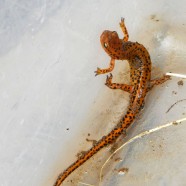Snow is Coming! Along with Our Cell Phone Tour!
With snow in the forecast for this weekend, its time to dust off the “Nature at Your Fingertips” signs and prepare them to go back out onto the winter trails once again! A lot is changing with our cell phone tours this year, so stay tuned for more exciting details soon to come!
Read MoreBrilliant Colors
An afternoon stroll down a dirt road lined with beautiful fall foliage, what could be better?! I hope you are enjoying the brilliant colors throughout the Chautauqua-Allegheny Region as it is a sight not to be missed! Elyse Henshaw Conservation Technician
Read MoreLong-tailed Salamander (Eurycea longicauda)
Earlier this summer I caught my first glimpse of this handsome salamander, appropriately named the Long-tailed Salamander (Eurycea longicauda). A species of Special Concern in New York State, this uncommon salamander is at the northern fringes of its range and can be found along much of the southern Allegheny Plateau. Long-tails prefer cool woodland seeps and streams, but can occasionally be found along river banks under flat rocks or logs. As the temperatures continue to drop these salamanders will work their way deeper into rock cracks and crevices in order to protect themselves from...
Read MoreDark-eyed Junco
It’s that time again! One of everyone’s backyard favorites, the Dark-eyed Junco (Junco hyemalis), is on the way south. These cute little birds are returning to yards like yours now if you are not one of the lucky few to have them year-round. Their autumn arrival, along with that of the White-throated Sparrow, is one of the first big signs of fall to me each October. I look forward to spending six months with friends like this. Scott Kruitbosch Conservation & Outreach Coordinator
Read MoreBlack-throated Blue Warbler (Setophaga caerulescens)
For those of you that guessed Black-throated Blue Warbler for our confusing fall warbler question, you would be correct! As you may have noticed both the prior photo and this photo of the Black-throated Blue Warbler features them in-hand after receiving a small silver band on one of their legs. While the birds migrate from the northeast, upon their return and possible recapture, ornithologists can gather a great deal of data as to where the birds may have traveled to, whether they return to the same breeding grounds year after year as well as what their overall state of health appears to be....
Read More








